Are Knee Tattoos Painful, or are they just misunderstood? At tattooat.com, we dive deep into the world of tattoos to offer insights, advice, and inspiration. Discover the truth about knee tattoo pain levels, preparation tips, aftercare guidance, and stunning design ideas to help you make an informed decision. Explore various tattoo placements, healing processes, and how to keep your ink vibrant.
1. Understanding the Pain Factor: Do Knee Tattoos Hurt?
Yes, knee tattoos are generally considered more painful than tattoos on other body parts. The bony nature of the kneecap and the sensitivity of the surrounding skin contribute to a heightened pain sensation. However, pain tolerance varies significantly from person to person.
Knee tattoos often rank high on the pain scale due to several factors. The skin around the knee is thin and directly covers bone, leaving less cushioning. Additionally, the knee’s constant movement can make the tattooing process more uncomfortable and the healing phase more challenging. According to tattoo artist Hanah Elizabeth (@hanahelizabethtattoo), “Knee tattoos tend to be up there on the pain scale for most. It’s a unique experience, painfully uncomfortable to sit still for, but not unbearable.” Despite the potential discomfort, many find that the beauty and personal significance of the tattoo outweigh the pain.
Why Are Knee Tattoos Considered More Painful?
Several factors contribute to the perception of knee tattoos as particularly painful:
- Thin Skin: The skin around the kneecap is quite thin, providing little barrier between the needle and the bone.
- Bony Area: The proximity of the bone intensifies the sensation of the needle.
- Nerve Endings: The knee area has many nerve endings, making it more sensitive.
- Constant Movement: The knee’s frequent movement can make the tattooing process more uncomfortable and prolong the healing process.
What is the Pain Level of Knee Tattoos Compared to Other Areas?
Knee tattoos are often compared to other notoriously painful spots, such as the ribs, feet, and elbows. While pain is subjective, most people rank knee tattoos higher on the pain scale than areas with more muscle or fat, like the thighs or upper arms. Understanding this can help you mentally prepare for the tattooing session.
How Can You Manage Pain During a Knee Tattoo Session?
Managing pain during a knee tattoo session involves several strategies:
- Mental Preparation: Knowing what to expect can help you manage your anxiety and perceived pain.
- Choose an Experienced Artist: A skilled artist can work efficiently, reducing the overall time and discomfort.
- Take Breaks: Don’t hesitate to ask for breaks during the session to stretch and relax.
- Stay Hydrated and Fed: Ensuring you’re well-hydrated and have eaten before the session can help stabilize your blood sugar and reduce sensitivity.
- Use Numbing Creams: Topical numbing creams can reduce pain, but consult with your artist beforehand to ensure they won’t interfere with the tattooing process.
Is It Worth Getting a Knee Tattoo Despite the Pain?
Many people find that the pain of getting a knee tattoo is worth it. The unique placement offers a distinctive canvas for artistic expression, and the final result can be a powerful statement of personal style. If you’re drawn to the aesthetic and meaning of a knee tattoo, careful preparation and realistic expectations can help you navigate the discomfort.
2. Timing is Everything: How Long Do Knee Tattoos Take?
The duration of a knee tattoo depends largely on the complexity of the design and the area it covers. Blackwork tattoos usually take less time than color tattoos. Color tattoos might require multiple sessions: one for the line work and another for coloring, with healing time in between. My own full-color pink peony knee tattoo by Hanah Elizabeth took about 4 hours with breaks.
The time required for a knee tattoo can vary widely based on several factors:
- Size and Complexity: A small, simple design will take less time than a large, intricate one.
- Color vs. Blackwork: Color tattoos generally take longer due to the need for multiple passes to layer the colors.
- Artist’s Speed: An experienced artist might complete the tattoo faster than someone newer to the craft.
- Breaks: Taking breaks can extend the overall time but can also make the process more comfortable.
- Skin Condition: Healthy, well-prepared skin will take the ink more easily, potentially reducing the time needed.
Talking to my friend Steph, her peony knee tattoo by Toby Gawler (@tattoosbytoby) took about 5-6 hours over two sessions.
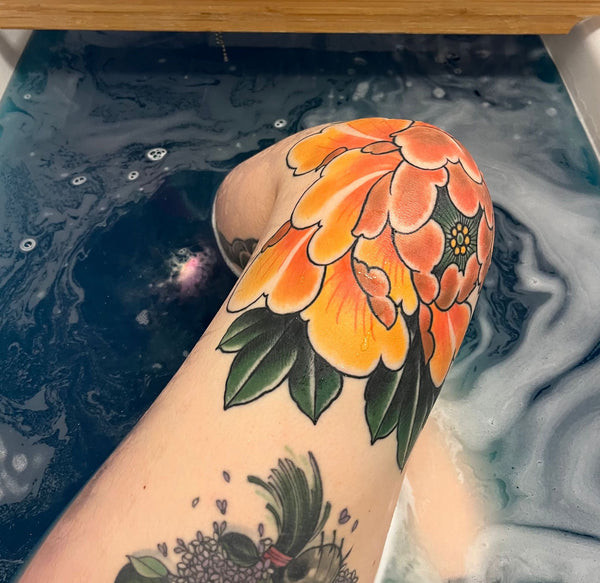 Knee tattoo by Toby Gawler
Knee tattoo by Toby Gawler
How to Estimate the Time Needed for Your Knee Tattoo?
To get an accurate estimate, consult with your tattoo artist. During the consultation, they can assess your design, consider its complexity, and provide a realistic timeframe. Be sure to discuss any concerns you have about sitting for extended periods.
Should You Break Up Your Knee Tattoo Session?
For larger, more intricate designs, breaking the tattoo session into multiple sessions can be beneficial. This approach allows your skin to heal between sessions, reducing trauma and making the overall process more manageable. It also gives you a chance to assess the tattoo’s progress and make any necessary adjustments.
What to Expect During a Long Tattoo Session?
If your knee tattoo requires a long session, be prepared for:
- Discomfort: Extended periods of tattooing can lead to increased discomfort and fatigue.
- Movement: Sitting still for hours can be challenging. Try to find comfortable positions and take breaks to stretch.
- Adrenaline: The adrenaline rush from the tattooing process can wane over time, potentially increasing sensitivity.
- Aftercare: The longer the session, the more crucial proper aftercare becomes to ensure optimal healing.
3. Understanding the Investment: How Much Do Knee Tattoos Cost?
Knee tattoo prices vary, with some artists charging per piece and others per hour. Hourly rates typically range from $80 to $200, so a large knee tattoo could cost between $300 and $1000 or more. The exact cost depends on the design, size, and artist’s location. Your tattoo artist will provide a price estimate during your consultation or in booking emails.
The cost of a knee tattoo can fluctuate significantly based on several key elements:
- Hourly Rate vs. Flat Rate: Some artists charge by the hour, while others offer a flat rate for the entire design.
- Design Complexity: Intricate designs with fine details and multiple colors will cost more than simpler designs.
- Artist’s Experience: Renowned and highly sought-after artists typically charge higher rates.
- Studio Location: Tattoo prices can vary by geographic location, with urban areas often being more expensive.
- Additional Sessions: If your tattoo requires multiple sessions, the overall cost will increase.
How to Get an Accurate Price Quote for Your Knee Tattoo?
To get an accurate price quote, schedule a consultation with your chosen tattoo artist. Bring your design ideas, discuss the size and placement, and ask for a detailed breakdown of the costs. Be transparent about your budget and any concerns you have.
Factors That Influence the Cost of a Knee Tattoo
Several factors can impact the cost of your knee tattoo:
- Custom Design: Custom designs often require more time and expertise, increasing the cost.
- Color Ink: Color inks can be more expensive and time-consuming to apply, adding to the overall price.
- Touch-Ups: While some artists offer free touch-ups, others may charge extra for them.
- Premium Inks: Some artists use premium-quality inks that can enhance the tattoo’s vibrancy and longevity, but they may come at a higher cost.
Budgeting for Your Knee Tattoo
When budgeting for your knee tattoo, consider not only the tattoo itself but also:
- Aftercare Products: Factor in the cost of aftercare creams, cleansers, and bandages.
- Tipping: It’s customary to tip your tattoo artist, usually around 15-20% of the total cost.
- Potential Touch-Ups: Set aside some funds for potential touch-ups down the line.
- Time Off: If your job requires physical activity, you may need to take time off.
4. Prepping for Success: How to Prepare for a New Knee Tattoo
Preparation is vital for any tattoo, but it’s even more important for painful spots like the knee. Exfoliate the area beforehand, as knees are often dry and thick-skinned. A good breakfast, mental preparation, and realistic expectations about the pain can also help.
Proper preparation can significantly impact your experience and the final result of your knee tattoo. Here’s a comprehensive guide:
- Skincare: Start moisturizing the knee area several days before your appointment to hydrate the skin.
- Exfoliation: Gently exfoliate the knee area to remove dead skin cells, making it easier for the artist to work.
- Hydration: Drink plenty of water in the days leading up to your appointment to keep your skin supple.
- Rest: Get a good night’s sleep before your session to ensure you’re relaxed and energized.
- Nutrition: Eat a nutritious meal before your appointment to maintain stable blood sugar levels.
- Clothing: Wear loose, comfortable clothing that allows easy access to your knee.
- Avoid Alcohol and Blood Thinners: Refrain from alcohol and blood-thinning medications for at least 24 hours before your appointment to minimize bleeding.
According to Hanah Elizabeth, “You can prepare the same way as you would with most other tattoos. Exfoliate the area beforehand as knees are notoriously dry and thick skinned, so any extra help you can give with skincare prior will help greatly. Having a nice big breakfast, mentally preparing for the session and being realistic with the process, expect it’s going to hurt a bit more than most others.”
What to Bring to Your Knee Tattoo Appointment?
Pack a bag with essentials to make your tattoo session more comfortable:
- Snacks and Drinks: Bring snacks and drinks to keep your energy levels up.
- Entertainment: Download a playlist, podcast, or e-book to help distract you during the session.
- Comfort Items: Bring a pillow or blanket for added comfort.
- Numbing Cream (if approved): If your artist approves, bring topical numbing cream to apply before the session.

Mental Preparation for a Knee Tattoo
Mental preparation is just as important as physical preparation. Visualize the tattoo process, set realistic expectations, and remind yourself why you want the tattoo. Deep breathing exercises and mindfulness techniques can help you stay calm and focused during the session.
Consultation with Your Tattoo Artist
Before your tattoo appointment, have a thorough consultation with your artist. Discuss your design ideas, placement, and any concerns you have about pain or the tattooing process. This is also an opportunity to review your artist’s portfolio and ensure they are experienced in tattooing knees.
5. Placement Perfection: Choosing Your Knee Tattoo Placement
There are several ways to place a knee tattoo. Some integrate the knee into a leg sleeve, while others treat it as a standalone space. Common placements include:
- Knee Cap Tattoo: Covers the kneecap, often in a traditional style with designs like peonies, bear heads, roses, mandalas, or sacred hearts.
- Above Knee Tattoo: Sits just above the kneecap, almost like a lower thigh tattoo. Ideal for floral frames, butterflies, cut-out mandalas, or two-word phrases across both legs.
- Under Knee Tattoo: Frames the kneecap from underneath, also known as an upper shin tattoo. Suitable designs include horseshoes, charm bracelets, flowers, moths, and bats.
The placement of your knee tattoo can significantly impact its appearance and overall aesthetic. Consider these options:
- Centered on the Knee: This placement emphasizes the knee as the focal point, often used for symmetrical designs.
- Wraparound: A wraparound tattoo extends around the knee, creating a dynamic and flowing design.
- Knee and Thigh Connection: This placement connects the knee tattoo with a design on the thigh, creating a cohesive and visually striking effect.
- Knee and Shin Connection: Similar to the thigh connection, this placement integrates the knee tattoo with a design on the shin.
Factors to Consider When Choosing Knee Tattoo Placement
When deciding on the perfect knee tattoo placement, consider these factors:
- Design Compatibility: Ensure the design you choose complements the shape and contours of your knee.
- Pain Tolerance: Some areas around the knee may be more sensitive than others.
- Movement: Consider how the tattoo will look when your knee is bent or straight.
- Clothing: Think about how the tattoo will be visible with different types of clothing.
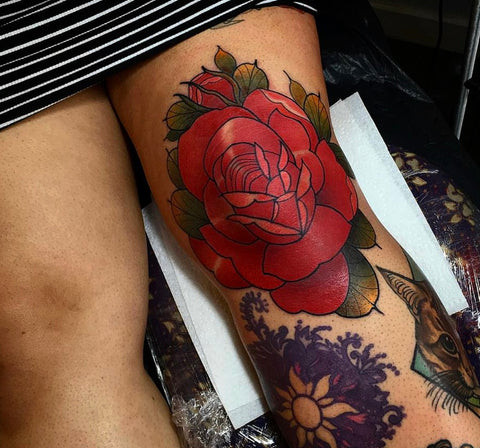 Knee tattoo
Knee tattoo
Knee Cap Tattoo
As you’ve guessed, a knee cap tattoo covers your knee cap. These tattoos tend to be in more of a traditional style and are usually a stand alone design. Think peony, bear head, rose, mandala or sacred heart.
Above Knee Tattoo
Sitting just above your knee cap, above the knee tattoos could almost be classed as lower thigh. This spot is perfect for a floral frame design that goes around your knee, other designs that could work are butterflies, cut out mandalas and barbed wire. Or I’ve seen a lot of people get a two word phrase that reads across both legs which look really cool.
 Knee tattoo
Knee tattoo
Under Knee Tattoo
Framing your knee cap from underneath, these tattoos are also called upper shin tattoos. Designs that suit this sort of shape and placement include horseshoes, chunky charm bracelets, flowers, floral bands, moths, and bats.
6. Healing Hurdles: How to Heal Your Knee Tattoo
Knees can be tricky to heal because the skin stretches and moves with walking, and they’re prone to swelling. Take a few days off to rest if possible. Use a good aftercare cream, avoid soaking the tattoo, don’t pick scabs, and elevate your leg.
Proper aftercare is essential for ensuring your knee tattoo heals well and looks its best. Here’s a step-by-step guide:
- Keep it Clean: Gently wash the tattoo with mild, fragrance-free soap and warm water 2-3 times a day.
- Pat Dry: Pat the tattoo dry with a clean paper towel instead of rubbing it.
- Apply Aftercare Cream: Apply a thin layer of aftercare cream or ointment to keep the tattoo moisturized.
- Avoid Soaking: Refrain from soaking the tattoo in baths, pools, or hot tubs.
- Wear Loose Clothing: Wear loose, breathable clothing to avoid friction and irritation.
- Avoid Sun Exposure: Protect the tattoo from direct sunlight by wearing protective clothing or using sunscreen.
- Don’t Pick or Scratch: Avoid picking or scratching the tattoo, as this can lead to infection and scarring.
According to tattooist Hanah, “Every artist has their own aftercare guidance and ideal way of doing things. Personally, I prefer to wet heal knee tattoos. I found that helpful with my own knee to avoid dry cracking with the amount of movement it has.”
Common Healing Challenges with Knee Tattoos
Knee tattoos present unique healing challenges due to the joint’s constant movement and flexibility:
- Cracking: The skin around the knee is prone to cracking, which can disrupt the healing process.
- Swelling: The knee area is susceptible to swelling, which can cause discomfort and prolong healing.
- Friction: Clothing and movement can cause friction, leading to irritation and potential infection.
- Infection: Improper aftercare can increase the risk of infection, which can damage the tattoo and your health.
How to Minimize Swelling and Discomfort During Healing
To minimize swelling and discomfort during the healing process:
- Elevate Your Leg: Elevate your leg whenever possible to reduce swelling.
- Apply Cold Compresses: Apply cold compresses to the tattoo for short periods to alleviate pain and swelling.
- Take Anti-Inflammatory Medication: Over-the-counter anti-inflammatory medications can help reduce swelling and discomfort.
- Rest: Avoid strenuous activities and give your knee time to heal.
When to Seek Professional Medical Advice
If you experience signs of infection, such as:
- Excessive Redness
- Swelling
- Pus or Drainage
- Fever
7. Fading Fears: Do Knee Tattoos Fade?
While tattoos can fade over time, proper care can keep them vibrant. Moisturize regularly and protect your skin from the elements. Lifestyle factors, such as being frequently on your knees or exposing your skin to harsh conditions, can also affect fading.
Tattoo fading is a common concern among tattoo enthusiasts. While all tattoos will fade to some extent over time, certain factors can accelerate the process:
- Sun Exposure: Prolonged sun exposure is a primary cause of tattoo fading.
- Skin Hydration: Dry skin can cause the tattoo to appear dull and faded.
- Friction: Constant friction from clothing or movement can wear down the ink.
- Ink Quality: Lower-quality inks are more prone to fading than premium inks.
- Placement: Tattoos in areas with high friction or sun exposure tend to fade faster.
Hanah explains that “everyone’s skin heals differently but, as long as you’re keeping your skin moisturised, there’s no reason why they should fade faster than others. People’s jobs and lifestyles will play a part in that – how often they’re on their knees or if their skin is open to the elements will affect the area like it would any other tattoo.”
How to Keep Your Knee Tattoo Vibrant
To keep your knee tattoo looking vibrant for years to come:
- Protect from Sun: Apply a high-SPF sunscreen to your tattoo whenever it’s exposed to the sun.
- Moisturize Regularly: Keep your skin hydrated by moisturizing daily with a tattoo-friendly lotion.
- Avoid Harsh Chemicals: Protect your tattoo from harsh chemicals, such as chlorine and strong detergents.
- Stay Healthy: A healthy lifestyle, including a balanced diet and regular exercise, can promote skin health and tattoo vibrancy.
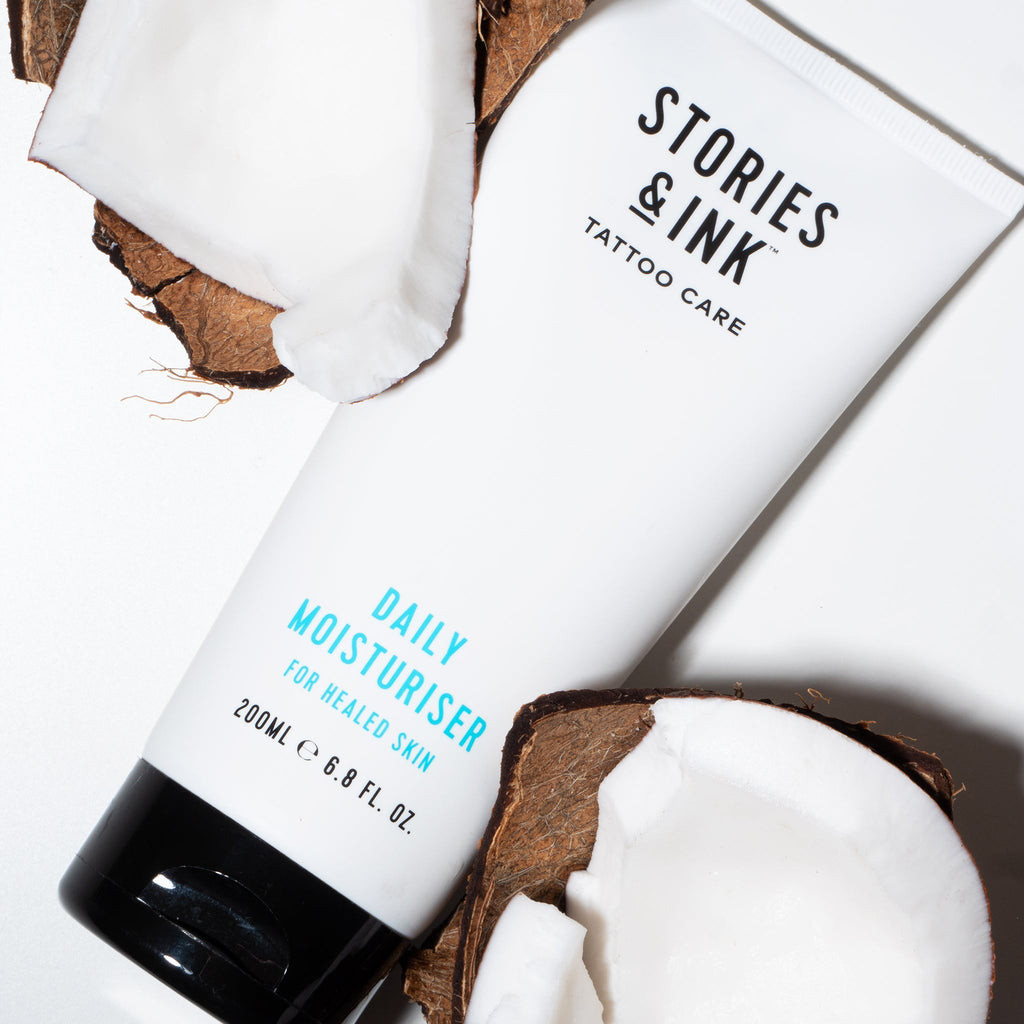
When to Consider a Touch-Up for Your Knee Tattoo
Even with proper care, knee tattoos may require touch-ups over time to restore their vibrancy and definition. Common signs that your tattoo needs a touch-up include:
- Fading: The colors appear dull or washed out.
- Blurring: The lines have become less defined.
- Inconsistencies: The ink is uneven or patchy.
Choosing the Right Touch-Up Artist
When seeking a touch-up artist, choose someone with experience in working with knee tattoos and a portfolio that showcases their skills. A skilled artist can refresh your tattoo and ensure it looks its best for years to come.
8. Tattooing After Surgery: Can You Get a Knee Tattoo After Surgery?
Yes, you can get a tattoo after knee surgery once your knee and any scars are fully healed. Tattoos can be a great way to boost self-esteem and cover scars. Consult your surgeon about how long to wait and find an artist specializing in tattooing over scars.
Getting a tattoo after surgery can be a positive way to reclaim your body and boost your confidence. However, it’s essential to proceed with caution and follow these guidelines:
- Consult Your Surgeon: Before getting a tattoo, consult with your surgeon to ensure your knee is fully healed and there are no contraindications.
- Wait for Full Healing: Wait until your scar has fully healed, which can take several months or even a year.
- Choose an Experienced Artist: Find a tattoo artist who specializes in tattooing over scars and has experience working with surgical scars.
- Discuss Your Expectations: Communicate your expectations with your artist and be realistic about what can be achieved.
- Consider the Scar Tissue: Scar tissue can be more challenging to tattoo than regular skin, so be prepared for a potentially longer and more uncomfortable session.
Potential Benefits of Tattooing Over Scars
Tattooing over scars can offer several benefits:
- Improved Appearance: Tattoos can camouflage scars, making them less noticeable.
- Increased Confidence: Covering scars with tattoos can boost self-esteem and body image.
- Personal Expression: Tattoos can be a form of personal expression and a way to reclaim your body after surgery.
- Emotional Healing: The process of getting a tattoo can be therapeutic and help you come to terms with your surgical experience.
Risks of Tattooing Over Scars
While tattooing over scars can be a positive experience, it’s essential to be aware of the potential risks:
- Infection: Scar tissue can be more prone to infection, so proper aftercare is crucial.
- Ink Rejection: Scar tissue may not hold ink as well as regular skin, leading to fading or unevenness.
- Pain: Tattooing over scars can be more painful than tattooing over regular skin.
- Unpredictable Results: The final outcome of the tattoo may be unpredictable due to the nature of scar tissue.
Tips for Choosing a Tattoo Design to Cover a Scar
When selecting a tattoo design to cover a scar, consider these tips:
- Choose a Bold Design: Bold, colorful designs tend to be more effective at camouflaging scars.
- Incorporate the Scar: Work with your artist to incorporate the scar into the design, making it a part of the artwork.
- Consider the Shape and Size: Choose a design that complements the shape and size of your scar.
- Be Patient: The process of tattooing over scars may require multiple sessions to achieve the desired result.
9. Inspiration Station: Our Top 5 Knee Tattoo Ideas
Need inspiration? Here are five fantastic knee tattoo ideas:
- Knee Mandala Tattoo: Ornamental tattoos that look great on their own or as part of a sleeve.
- Knee Spider Web Tattoo: A classic design that looks amazing on knees.
- Floral Knee Tattoos: Flowers always make great tattoos, especially peonies.
- Industrial Knee Tattoos: Chain-locked fence tattoos are a trendy and edgy choice.
- The Bee’s Knees: A pun tattoo with bees under the knees is a fun and unique idea.
Knee Mandala Tattoo
Who doesn’t love a mandala tattoo? These ornamental tattoos look great on their own covering a knee cap or part of a sleeve. Like this one by @6rilink.
Knee Spider Web Tattoo
Classic, cobweb tattoos look amazing anywhere, from top of ears to knees.
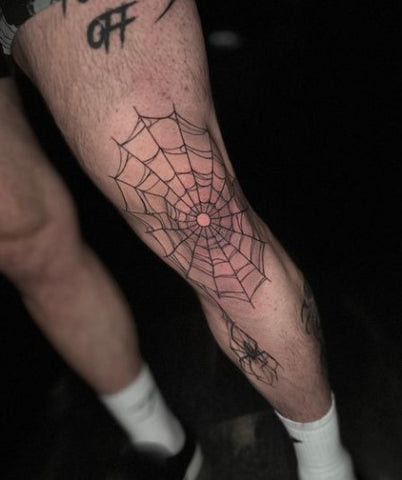 Knee tattoo
Knee tattoo
Floral Knee Tattoos
Flowers always make for great tattoos. I’m a huge fan of peonies, as their name suggests (peon-knee) they’re perfect for your knees. I even have a peo-knee tattoo myself, so I had to include them in this ideas list.
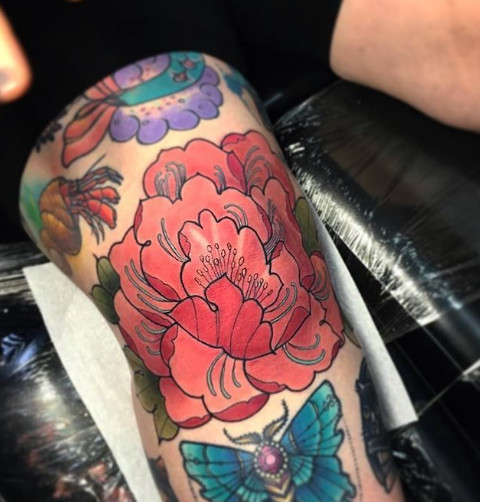 Knee tattoo
Knee tattoo
Industrial Knee Tattoos
Chain locked fence tattoos have been making rounds in the tattoo world for a while. @lucyarbeit does a lot of it, we love these broken fence knee tattoos.
The Bee’s Knees
From the amount of bees on knees tattooed I’ve seen, I know I’m not the only one who loves a pun tattoo. Sitting under the knees, these bees are awesome.
10. FAQ: Answering Your Burning Questions About Knee Tattoos
Still have questions? Here are some frequently asked questions about knee tattoos:
Are knee tattoos more likely to get infected?
Yes, knee tattoos can be more prone to infection due to the joint’s movement and the skin’s tendency to crack. Proper aftercare is crucial to prevent infection.
Can I exercise after getting a knee tattoo?
Avoid strenuous exercise that puts stress on your knee for at least 1-2 weeks after getting a tattoo. Light activities like walking are generally okay, but consult your tattoo artist for personalized advice.
How do I prevent my knee tattoo from cracking?
Keep your knee tattoo moisturized with a high-quality aftercare cream and avoid activities that cause excessive stretching or friction.
What type of clothing should I wear after getting a knee tattoo?
Wear loose, breathable clothing that doesn’t rub against your new tattoo. Avoid tight pants or anything that restricts movement.
Are there any specific aftercare products I should use for my knee tattoo?
Look for aftercare products that are specifically designed for tattoos, fragrance-free, and hypoallergenic. Consult your tattoo artist for recommendations.
What should I do if I notice signs of fading in my knee tattoo?
If you notice fading, protect your tattoo from the sun, moisturize regularly, and consider getting a touch-up to restore its vibrancy.
How long does it take for a knee tattoo to fully heal?
A knee tattoo typically takes 2-4 weeks to heal, but full healing can take up to 6 months.
Can I shave my knee after getting a tattoo?
Wait until your tattoo is fully healed before shaving your knee. Use a clean razor and shave gently to avoid irritating the skin.
Is it okay to use numbing cream before getting a knee tattoo?
Consult your tattoo artist before using numbing cream, as some products can affect the tattooing process.
What are the best designs for knee tattoos?
The best designs for knee tattoos depend on your personal preferences and the placement you choose. Popular options include mandalas, spider webs, flowers, and geometric patterns.
Ready to explore more stunning tattoo designs, find talented artists, and learn everything you need to know about tattoos? Visit tattooat.com today! Discover inspiration, connect with top artists, and dive deep into the world of tattoo art. Your perfect tattoo journey starts here.
Address: 1825 SW Broadway, Portland, OR 97201, United States. Phone: +1 (503) 725-3000. Website: tattooat.com.
